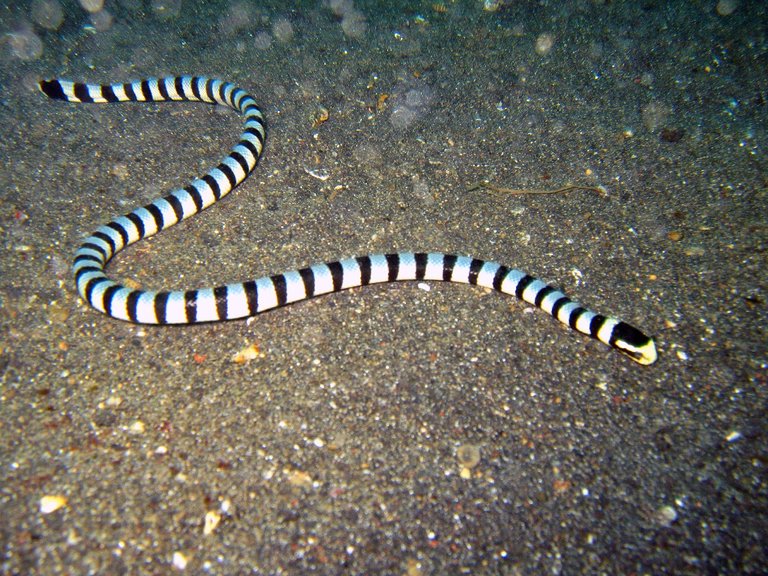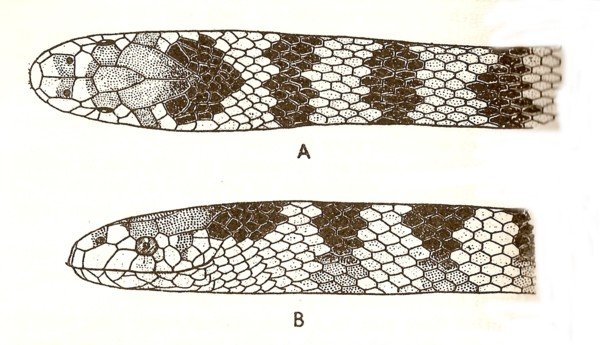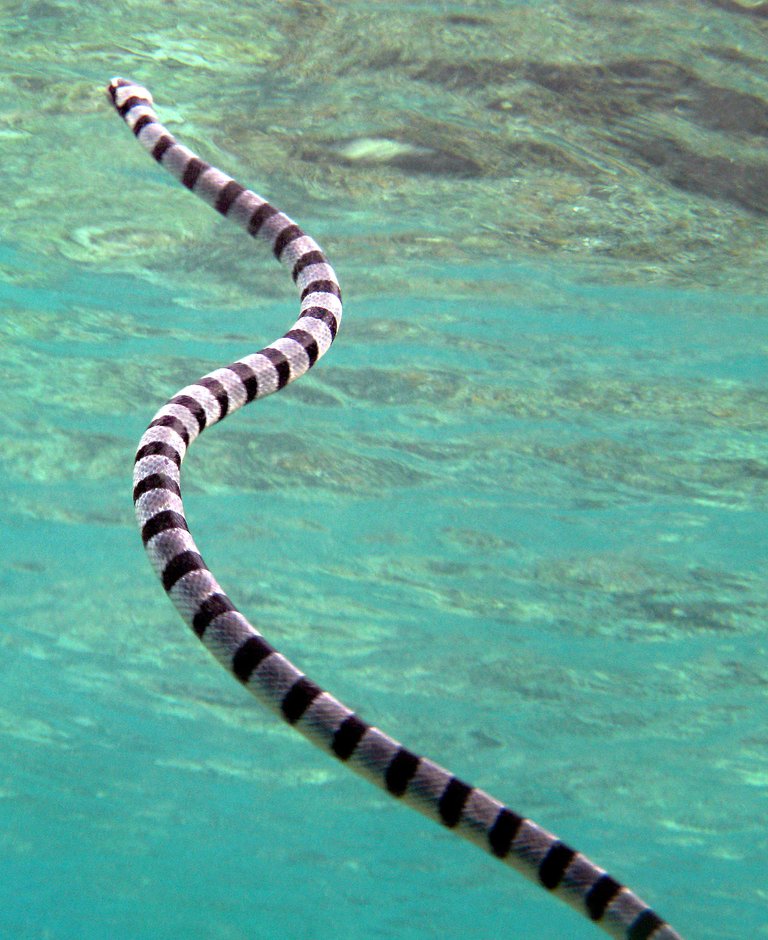The Hydrophiinae, regularly known as ocean snakes or coral reef snakes, are a subfamily of venomous elapid winds that occupy marine conditions for most or the majority of their lives. Most are broadly adjusted to a completely sea-going life and can't proceed onward arrive, with the exception of the family Laticauda, which has restricted land development. They are found in warm beach front waters from the Indian Ocean to the Pacific and are firmly identified with venomous earthbound snakes in Australia.

All have paddle-like tails and many have horizontally packed bodies that give them an eel-like appearance. Not at all like fish, they don't have gills and must surface frequently to relax. Alongside whales, they are among the most totally oceanic of all air-breathing vertebrates. Among this gathering are species with probably the most powerful venoms of all snakes. Some have delicate attitudes and chomp just when incited, however others are significantly more forceful. As of now, 17 genera are portrayed as ocean snakes, containing 62 species.
The majority of adult Hydrophiinae species grow to between 120 and 150 cm (3.9 and 4.9 ft) in length, with the largest, Hydrophis spiralis, reaching a maximum of 3 m (9.8 ft). Their eyes are relatively small with a round pupil and most have nostrils located dorsally. The skulls do not differ significantly from those of terrestrial elapids, although the dentition is relatively primitive with short fangs and (with the exception of Emydocephalus) as many as 18 smaller teeth behind them on the maxilla. Read more (1)
Most Hydrophiinae are totally sea-going and have adjusted to their surroundings from multiple points of view, the most normal for which is an oar like tail that has enhanced their swimming capacity. To a differing degree, the collections of numerous species are along the side packed, particularly in the pelagic species. This has frequently made the ventral scales end up plainly decreased in measure, even hard to recognize from the abutting scales. Their absence of ventral scales implies they have turned out to be for all intents and purposes powerless ashore, yet as they experience their whole lifecycles adrift, they have no compelling reason to leave the water.
The main sort that has held the augmented ventral scales is the ocean kraits, Laticauda, with just five species. These snakes are thought to be more primitive, as regardless they invest a lot of their energy in arrive, where their ventral scales bear the cost of them the vital hold. Laticauda species are additionally the main ocean snakes with internasal scales, i.e., their nostrils are not found dorsally.
Since it is less demanding for a snake's tongue to satisfy its olfactory capacity submerged, its activity is short contrasted with that of earthly snake species. Just the forked tips jut from the mouth through a separated score amidst the rostral scale. The nostrils have valves comprising of a particular light tissue to bar water, and the windpipe can be attracted up to where the short nasal entry opens into the top of the mouth. This is an imperative adjustment for a creature that must surface to inhale, however may have its head halfway submerged while doing as such. The lung has turned out to be huge and expands practically the whole length of the body, in spite of the fact that the back part is thought to have created to help lightness as opposed to trade gasses. The stretched out lung perhaps at the same time serves to store air for jumps
Sensory Abilities.
Vision, chemoreception (tongue-flicking) and hearing are critical faculties for earthbound snakes yet these jolts wind up noticeably twisted in water. The poor perceivability, synthetic weakening and confinement of ground-borne vibrations submerged recommend that ocean snakes and ocean kraits may have special tangible capacities to make up for the relative absence of other tactile prompts.

Next to no is thought about ocean wind vision. An investigation of retinal photoreceptors of spine-bellied, Lapemis curtus, and horned, Acalyptophis peronii, ocean snakes discovered three classes of visual colors all from cone cells. Regardless of the nonappearance of bar cells in ocean wind eyes, Simeos et al. discovered qualities from bar cells were all the while being communicated proposing that in ocean winds a few cones might be transmuted bars. Nonetheless, behavioral perceptions show that vision has a constrained part to catch prey and mate determination, yet stable (i.e. vibration) and chemoreception might be essential. One investigation distinguished little tangible organs on the head of Lapemis curtus like the mechanoreceptors in crocs and oceanic snake Acrochodus that are utilized to detect the development of fish prey. Westhoff et al. recorded sound-related mind reactions to vibration submerged in Lapemis curtus, which are sufficiently touchy to recognize development in prey yet were not as delicate as fish parallel line frameworks. Correspondingly, vision has all the earmarks of being of restricted significance for discovering mates. Sparkle explored different avenues regarding applying skin emissions (pheromones) to wind like items to check whether male turtle-headed ocean snakes, Emydocephalus annulatus, are pulled in to female pheromones. Sparkle found that despite the fact that vision might be valuable over short separations (<1 m), pheromones are more critical once the male comes in physical contact with a protest.
Sensory Abilities
Vision, chemoreception (tongue-flicking) and hearing are critical faculties for earthbound snakes yet these jolts wind up noticeably twisted in water. The poor perceivability, synthetic weakening and confinement of ground-borne vibrations submerged recommend that ocean snakes and ocean kraits may have special tangible capacities to make up for the relative absence of other tactile prompts.
Next to no is thought about ocean wind vision. An investigation of retinal photoreceptors of spine-bellied, Lapemis curtus, and horned, Acalyptophis peronii, ocean snakes discovered three classes of visual colors all from cone cells. Regardless of the nonappearance of bar cells in ocean wind eyes, Simeos et al. discovered qualities from bar cells were all the while being communicated proposing that in ocean winds a few cones might be transmuted bars. Nonetheless, behavioral perceptions show that vision has a constrained part to catch prey and mate determination, yet stable (i.e. vibration) and chemoreception might be essential. One investigation distinguished little tangible organs on the head of Lapemis curtus like the mechanoreceptors in crocs and oceanic snake Acrochodus that are utilized to detect the development of fish prey. Westhoff et al. recorded sound-related mind reactions to vibration submerged in Lapemis curtus, which are sufficiently touchy to recognize development in prey yet were not as delicate as fish parallel line frameworks. Correspondingly, vision has all the earmarks of being of restricted significance for discovering mates. Sparkle explored different avenues regarding applying skin emissions (pheromones) to wind like items to check whether male turtle-headed ocean snakes, Emydocephalus annulatus, are pulled in to female pheromones. Sparkle found that despite the fact that vision might be valuable over short separations (<1 m), pheromones are more critical once the male comes in physical contact with a protest.
The olive sea snake, Aipysurus laevis, has been found to have photoreceptors in the skin of its tail, allowing it to detect light and presumably ensuring it is completely hidden, including its tail, inside coral holes during the day. While other species have not been tested, Aipysurus laevis possibly is not unique among sea snakes in this respec. Read more : (2)
Distribution and habitat.
The Hydrophiinae are for the most part limited to the warm tropical waters of the Indian Ocean and the western Pacific Ocean, with a couple of animal types discovered well out into Oceania. The geographic scope of one animal types, Pelamis platurus, is more extensive than that of some other reptile species, with the exception of a couple of types of ocean turtles. It stretches out from the east bank of Africa, from Djibouti in the north to Cape Town in the south, over the Indian Ocean, the Pacific, south to the extent the northern shoreline of New Zealand, the distance toward the western shoreline of the Americas, where it happens from northern Peru in the south (counting the Galápagos Islands) to the Gulf of California in the north. Confined examples have been found as far north as San Clemente in the United States.
Sea snakes do not occur in the Atlantic Ocean. It is thought that Pelamis would be found there were it not for the cold currents off Namibia and western South Africa that keep it from crossing into the eastern South Atlantic, or south of 5° latitude along the South American west coast. Sea snakes do not occur in the Red Sea, believed to be due to its increased salinity, so no danger exists of them crossing through the Suez Canal. A lack of salinity is also thought to be the reason why Pelamis has not crossed into the Caribbean via the Panama Canal. Read more : (3)
Captivity.
Best case scenario, Hydrophiinae make troublesome hostages. Ditmars (1933) portrayed them as anxious and sensitive prisoners that more often than not decline to eat, favoring just to stow away in the darkest corner of the tank. More than 50 years after the fact, Mehrtens (1987) composed, in spite of the fact that they were infrequently shown in Western zoological parks, a few species were routinely in plain view in Japanese aquariums. Accessible sustenance supply restricts the quantity of species that can be kept in bondage, since some have diets that are excessively particular. Additionally, a few species seem prejudiced of taking care of, or notwithstanding being expelled from the water. As to prerequisites in bondage, the Laticauda species should have the capacity to leave the water some place at around 29 °C, alongside a submerged safe house.

|
|---|
Reference : Link


Sampai saat ini saya belum pernah melihat hydrophiinae di Aceh. Apa bg @ejhaasteem pernah menjumpai hewan ini?